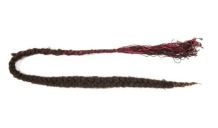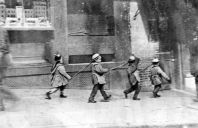Mix and match
Our queue is a mix and match of, at least, human hair and silken thread. Clearly, the diversifying of the queue did not stop with the three styles from early, mid and late Qing. If the Qing queue was once a way to take away the ability to communicate power and personal taste, then that way was forgotten. But there is more. Ernst von Hesse-Wartegg wrote around 1900:
Of course, [a queue] will only be long enough after years of braiding. In the masculine age, the natural hair on the head of the Chinese reaches up to about half the back, for some it even reaches a length of one meter and more, but artificial means must always be used to give the braid the required length up to the ankles . A strand of human or horse hair is usually braided into natural hair, … around the seat part it consists only of a network of silk cords of black or red color with a silk tassel at the end. If the Chinese are in mourning for their parents or close relatives, they are not allowed to braid or have their hair trimmed or braided for a period of seven weeks. If the emperor dies, this rule applies to all Chinese for a period of one hundred days, and in such circumstances it is easy to imagine the desolate appearance of these millions of people, a nation of Struwelpeters. The poor barbers have during this time vacation against their will, and many gnaw on hunger. Certainly no one in the immense realm will pray more eagerly for the health and longevity of the father of the country than these knights of the razor do. When the first period of deep mourning has passed, the Chinese weave white in the back appendage instead of the black silk strings because white is the color of their mourning. People who travel a lot or do things in the streets of cities use blue cords instead of white, which show less dirt.[cf]
In contemporary imagery and writing, we did not find evidence of the mix-and-match practices before the 1850s. Does this mean, however, that mixing was not common before that date? The idea that human hair or horsehair is mixed in with a living queue speaks to the imagination, and would even be worth testing with the queues sitting in our museum collections.
Back to our queue. We see real hair, whether it was of one person or only human, we do not know (yet). The use of extensions is something that we also see in photographs, not only in adults but also in children (that seem to be younger than twelve; the age from which Von Hesse-Wartegg said that boys could start wearing a queue). While we found more black extensions, the added red extension cords come in second. It suggests that our queue was not cut off during sorrowful times of mourning, since red is used during good times. However, Ball writes that:
an affectionate husband, as the author himself has seen, will sometimes put on white at his wife's funeral, though it is not incumbent on him to do so, or even to attend the corpse to the grave; in the same way, some abstain from red cord in the queue, and bright colours, though it is not obligatory to do so. [cf]





